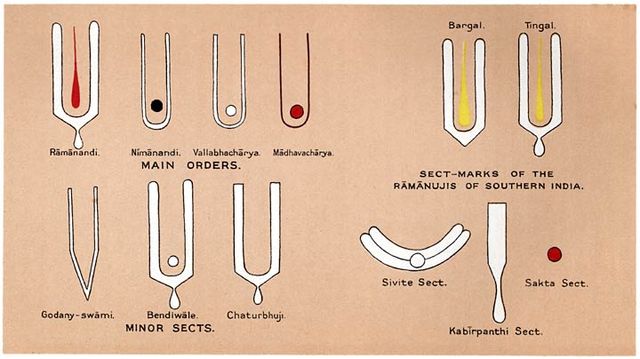Loading AI tools
Mark worn on the forehead and other parts of the body From Wikipedia, the free encyclopedia
In Hinduism, the tilaka (Sanskrit: तिलक), colloquially known as a tika, is a mark worn usually on the forehead, at the point of the ajna chakra (third eye or spiritual eye) and sometimes other parts of the body such as the neck, hand, chest, or the arm.[1] The tilaka may be worn daily for decorative purposes, as a symbol for sectarian affiliation, for rites of passage or for special spiritual and religious occasions, depending on regional customs.[2][3] It is also used as an expression of honour or to welcome someone upon arrival.[4]

Tilakas come in an assortment of styles or shapes and are adorned using various material such as "ash from sacrificial fire or cow dung, sandalwood paste, turmeric, clay, charcoal or red lead."[5][6][7]
Different Hindu denominations use different materials and shapes to make the tilaka.[6]
Traditionally, a staunch Vaishnavite would mark twelve parts of the body with tilakas and other symbols, but the most prominent tilaka is displayed on the forehead. The Vaishnava tilaka, also known as urdhva pundra, consists of a two or three vertical lines starting from just below the hairline to almost the end of one's nose tip, and intercepted in the middle by an elongated U. The style of the urdhva pundra varies in each Vaishnavite sect throughout India and can be made with sandalwood paste or various other materials.[3][7]

According to Dr. Vijay Prakash Sharma, the known styles include:[8]
Additional styles include: Vallabha Sampradaya Tilaka, Sri Tilaka of Rewasa Gaddi, Ramacharandas Tilaka, Srijiwarama tilaka, Sri Janakraja Kishori Sharan Rasik Aliji tilaka, Sri Rupkalajee tilaka, Rupsarasji tilaka, Ramasakheeji tilaka, Kamanendu Mani tilaka, Karunasindhuji tilaka, Swaminarayana Tilaka, Nimbarka tilaka, and Madhva tilaka.[10]
The Vasudeva Upanishad, a Vaishnava tradition text, explains the significance of three vertical lines in urdhva pundra tilaka to be a reminder of Brahma, Vishnu, Shiva; the Vedic scriptures – Rigveda, Yajurveda and Samaveda; three worlds Bhu, Bhuva, Svar; the three syllables of Om – a, u, m; three states of consciousness – awake, dream sleep, deep sleep; three realities – Maya, Brahman and Atman; the three bodies – sthula, sukshma, and karana.[11][12]

The Tripundra or Rudra-tilaka is the other major tilaka variant, often worn by the followers of Shiva.[13][14] It consists of three horizontal bands across the forehead with a single vertical band or circle in the middle. This is traditionally done with sacred ash from sacrificial fires, also known as vibhuti. The use of vibhuti is symbolic of detachment to the world or renunciation.[15] This variant is the more ancient of the two and shares many common aspects with similar markings worn across the world.[3]
Chapter 2 of the Kalagni Rudra Upanishad, a Shaiva traditional text, explains the three lines of a Tilaka as a reminder of various triads: three sacred fires, three syllables in Om, three gunas, three worlds, three types of atman (self), three powers in oneself, first three Vedas, three times of extraction of the Vedic drink Soma.[16][17]
These lines, represent Shiva's threefold power of will (icchāśakti), knowledge (jñānaśakti), and action (kriyāśakti).[18] The Tripuṇḍra described in this and other Shaiva texts also symbolises Shiva's trident (trishula) and the divine triad of Brahma, Vishnu, and Shiva.[18]

Shaktas, worshippers of the various forms of the Goddess (Devi), wear a red dot on the forehead in the middle of three horizontal lines or a semicircular line.[1][19]
Followers of Ganapatya use red sandal paste (rakta candana).[20]
Jains wear the tilaka to mark the forehead of Jaina images with sandalwood paste, during puja ceremonies.[21] It may also be used, for the same reason, to mark idols at the start of a puja (worship), to mark a rock or tree before it is cut or removed from its original place for artisan work, or to mark a new piece of property.[4][22]
Although bindi is related to tilaka there are a few notable differences. Bindi is a dot worn mainly by married Hindu women on the forehead and generally red in color, symbolizing good fortune. Today, it can be found in an assortment of colors, shapes, materials and mainly worn for decorative purposes.[23][24]
Seamless Wikipedia browsing. On steroids.
Every time you click a link to Wikipedia, Wiktionary or Wikiquote in your browser's search results, it will show the modern Wikiwand interface.
Wikiwand extension is a five stars, simple, with minimum permission required to keep your browsing private, safe and transparent.